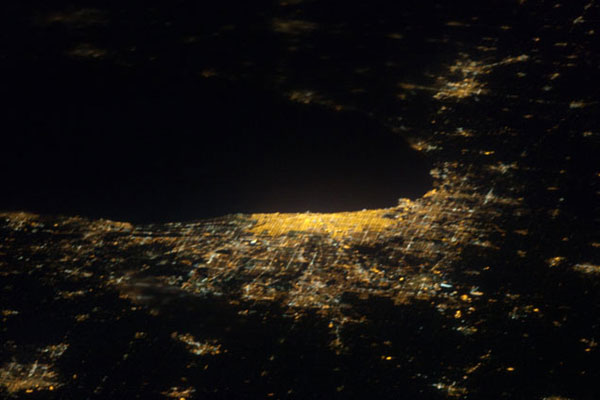Here’s how astronauts see us, or at least used to, back when we had astronauts:

That’s set to change, at least a bit, as the city rolls out 16,300 ceramic metal halide street lights with the help of $13.8 million from the Department of Energy. It’s only about 6.5 percent of the 250,000 street lights in the city (up over 100 percent since 1910!). The lights are Phillips CosmoPolis, "the category killer in white streetlighting," according to Lux magazine:
The benefits of white light from ceramic metal halide lamps in the public realm are legion. For a start, you can deliver less output under the codes – because people’s perception with white is better, you can use less.
You can see the results, if they haven’t made it to your neighborhood, at lighting-gallery.net, where an administrator writes: "The dimmer white light gives the blocks with CMH and LED a more suburban look."
High-pressure sodium lights were a pure efficiency choice, and it’s remarkable how hated they are. As Hal Espen recently wrote in the Atlantic:
The jaundiced weirdness of sodium light has become a vexing challenge to photographers (one filmmaker, Tenolian Bell, called it “the ugliest light known to the cinematographer”); movie cameras simulate its color by using a gel filter named Bastard Amber. Significantly, retailers have avoided inflicting the unpleasantness of sodium lights on their customers—most commercial parking lots and shopping malls use the costlier white metal halide lights.
Just aesthetes overthinking things? No! Science proves that we hate HPS lights (emphasis mine):
HPS and MH installations were compared in terms of perceptions of brightness and safety, acceptability for social interaction, facial recognition and eyewitness identification. At equal photopic light levels, a street scene illuminated at night by an MH lighting system was reliably seen as brighter and safer than the same scene illuminated by an HPS system. In terms of acceptability for social interaction, facial recognition and many aspects of eyewitness identification, the measured differences between lighting systems were not as clear.
Again, we’re not replacing that many lights yet, but it’ll be interesting to see if there’s a greater perception of safety in the metal-halide neighborhoods.
Photograph: NASA



